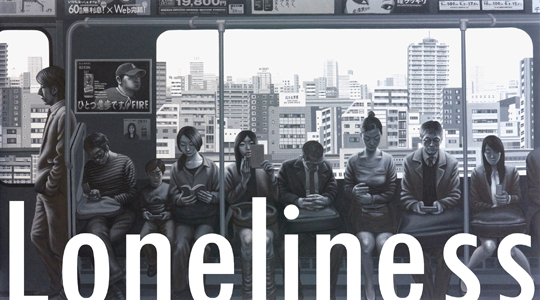Studio 24
Loneliness
Tanzil Shafique

Studio Description
“You can be lonely anywhere, but there is a particular flavour to the loneliness that comes from living in a city, surrounded by millions of people.”
- Olivia Laing, The Lonely City: Adventures in the Art of Being Alone
Do you feel lonely?
Well, if you do,
then you are not alone!
“Loneliness is the global epidemic of our times”- runs multiple news headlines. Research from social neuroscience and psychology is pointing towards a global trend in urban isolation, and a recent lifeline survey in Australia found 60% of respondents saying they often felt lonely. Studies conclude that loneliness is a greater public health issue than obesity, and chronic social isolation is worse than smoking 15 cigarettes a day. Taking into consideration the psychological effect places have on us, the premise of the studio is to explore the role of architects and urban designers in such a social context.
The studio, after analysing existing urban fabrics and conditions, will design strategic speculative urban ‘response assemblages’ that foster prosociality.
Open to architecture and urban design students, this studio is an attempt to answer Christine Murray, the Editor-in-Chief of the Architectural Review, who asked in her editorial in 2015, ‘Could architecture play a role in curing loneliness?’
Employing the crisis of loneliness as a point of departure and an opportunity for imagining alternative futures, this studio will attempt to first understand the spatial dynamics of this wicked problem. What role do urban morphologies play in loneliness? Recognizing the complexity of the problem and moving beyond the modernist notion of deploying architecture as a ‘solution’, secondly the studio will proceed to design strategic responses as the final design outcome, thinking about how loneliness can be mitigated by creating affordances and subtle cues. Applying the concept of Assemblage from Deleuze and Guattari, the studio outcomes will be speculative alliances of architectural form making, text and media output, tactical urban adaptations, landscape strategies, social innovations and novel financial arrangements. The studio will invite architects, social psychologists and urban thinkers working on the issue of loneliness to create a transdisciplinary basis of design responses.
Studio Outcomes
Studio Outcomes:
- Gain an understanding of the social and political role of design, architecture and urbanism.
- Value social resilience and develop a holistic notion of sustainability.
- Practice collaborative problem-solving through design moving beyond disciplinary silos.
- Question the prevalent practices of architecture and urbanism that are unaware of social consequences.
- Experiment with forms of drawing social interactions in built environment.
- A publication with the studio materials.
- Not feel lonely !
Studio Format:
- Week 1-4: Designing the question (site investigation, precedent analysis)
- Week 5: Design Charrette (Speculation)
- Week 6: Mid-semester Reviews (Reflection and inputs)
- Week 7-10: Design Development (Synthesis)
- Week 11-12: Design Representation (Narrative)
Studio Design Scope: The studio outcome can range from designing urban artefacts such as a hugging booth, designing pop-up parks, sub-urban retrofitting to a utopian speculation on anti-lonely city! Responses are based on student investigations, therefore, no pre-given site or program.
Studio Leader
Tanzil Shafique, Assoc. AIA, is a Ph.D researcher at the Melbourne School of Design looking at informal urbanism. He co-founded and now co-directs Estudio Abierto/Open Studio, a think+do tank on architecture and urbanism. Previously he was a Research Fellow and Studio Instructor at the Fay Jones School of Architecture + Design as well as Project Designer at the Community Design Center, both at the University of Arkansas. His work has garnered numerous AIA National Award for Urban Design as well as his writing on design philosophy and urbanism has been published internationally. He holds an M.Arch in Ecological Urbanism from Rensselaer Polytechnic Institute in New York.
Reading & Reference
Colin Ellard, Places of the Heart: The Psychogeography of Everyday Life (2015)
Sarah W. Goldhagen, Welcome to Your World: How the Built Environment Shapes Our Lives (2017)
Ann Sussman & Justin B Hollander, Cognitive Architecture: Designing for How We Respond to the Built Environment (2014)
Philip Tidwell (Ed.), Architecture and Empathy (2015)
Robert D. Putnam, Bowling Alone: The Collapse and Revival of American Community (2001)
Bill Bishop. The Big Sort: Why the Clustering of Like-Minded America is Tearing Us Apart (2009)
Eric Klinenberg, Palaces for the People: How Social Infrastructure Can Help Fight Inequality, Polarization, and the Decline of Civic Life (2018)
Jeremy Rifkin, The Empathic Civilization: The Race to Global Consciousness in a World in Crisis (2009)
John T. Cacioppo, William Patrick, Loneliness: Human Nature and the Need for Social Connection (2009)
Ben Lazare Mijuskovic, Loneliness in Philosophy, Psychology, and Literature (2012)
Mathew Lieberman, Social: Why Our Brains Are Wired to Connect (2014)
Grattan Institute, Social Cities (2012) ( available at: https://grattan.edu.au/wp-content/uploads/2014/04/137_report_social_cities_web.pdf )
https://www.architectural-review.com/rethink/letters-from-the-editor/could-architecture-play-a-role-in-curing-loneliness/10000071.article
https://www.theglobeandmail.com/life/life-of-solitude-a-loneliness-crisis-is-looming/article15573187/
http://www.bbc.com/future/story/20170605-the-psychology-behind-your-citys-design
ST1/24 Monday 12-3PM, MSD Room 239
ST2/24 Thursday 6:15-9:15PM, MSD Room 238